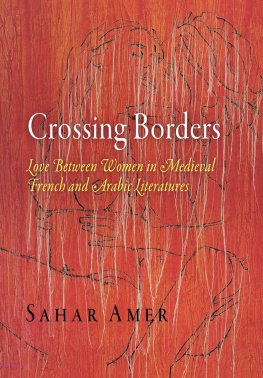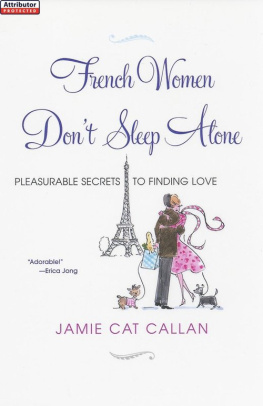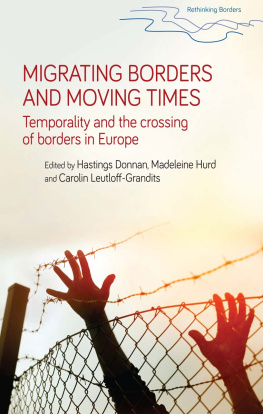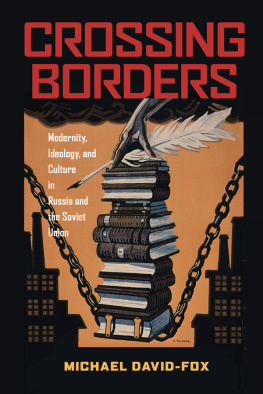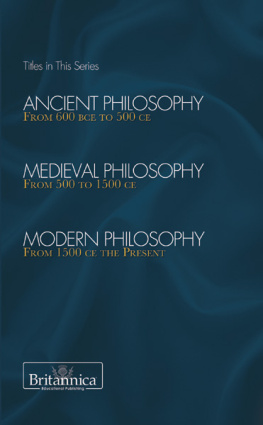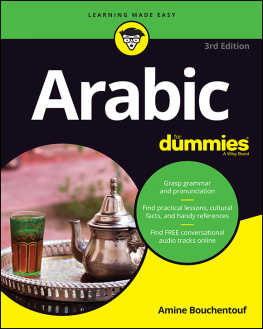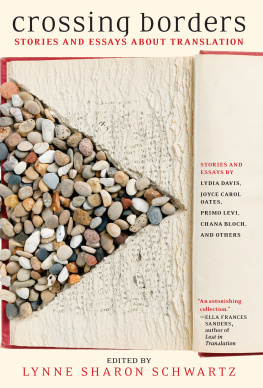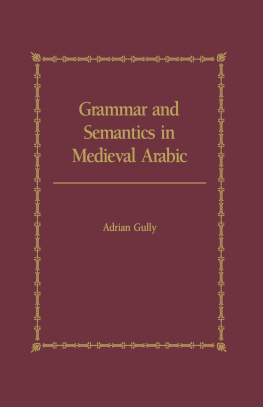Amer - Crossing borders: love between women in medieval French and Arabic literatures
Here you can read online Amer - Crossing borders: love between women in medieval French and Arabic literatures full text of the book (entire story) in english for free. Download pdf and epub, get meaning, cover and reviews about this ebook. City: Philadelphia, year: 2008, publisher: University of Pennsylvania Press, genre: Romance novel. Description of the work, (preface) as well as reviews are available. Best literature library LitArk.com created for fans of good reading and offers a wide selection of genres:
Romance novel
Science fiction
Adventure
Detective
Science
History
Home and family
Prose
Art
Politics
Computer
Non-fiction
Religion
Business
Children
Humor
Choose a favorite category and find really read worthwhile books. Enjoy immersion in the world of imagination, feel the emotions of the characters or learn something new for yourself, make an fascinating discovery.
- Book:Crossing borders: love between women in medieval French and Arabic literatures
- Author:
- Publisher:University of Pennsylvania Press
- Genre:
- Year:2008
- City:Philadelphia
- Rating:5 / 5
- Favourites:Add to favourites
- Your mark:
- 100
- 1
- 2
- 3
- 4
- 5
Crossing borders: love between women in medieval French and Arabic literatures: summary, description and annotation
We offer to read an annotation, description, summary or preface (depends on what the author of the book "Crossing borders: love between women in medieval French and Arabic literatures" wrote himself). If you haven't found the necessary information about the book — write in the comments, we will try to find it.
Amer: author's other books
Who wrote Crossing borders: love between women in medieval French and Arabic literatures? Find out the surname, the name of the author of the book and a list of all author's works by series.
Crossing borders: love between women in medieval French and Arabic literatures — read online for free the complete book (whole text) full work
Below is the text of the book, divided by pages. System saving the place of the last page read, allows you to conveniently read the book "Crossing borders: love between women in medieval French and Arabic literatures" online for free, without having to search again every time where you left off. Put a bookmark, and you can go to the page where you finished reading at any time.
Font size:
Interval:
Bookmark:
Crossing Borders
THE MIDDLE AGES SERIES
Ruth Mazo Karras, Series Editor
Edward Peters, Founding Editor
A complete list of books in the series is available from the publisher.
Love Between Women
in Medieval French and Arabic Literatures
Sahar Amer

Copyright 2008 University of Pennsylvania Press
All rights reserved. Except for brief quotations used for purposes of review or scholarly citation, none of this book may be reproduced in any form by any means without written permission from the publisher.
Published by
University of Pennsylvania Press
Philadelphia, Pennsylvania 191044112
Printed in the United States of America on acid-free paper
10 9 8 7 6 5 4 3 2 1
Library of Congress Cataloging-in-Publication Data
Amer, Sahar.
Crossing borders : love between women in medieval French and Arabic literatures / Sahar Amer.
p. cm. (The Middle Ages series)
Includes bibliographical references and index.
ISBN-13: 978-0-8122-4087-0 (hardcover : alk. paper)
1. French literatureTo 1500History and criticism. 2. Arabic literatureHistory and criticism. 3. Lesbians in literature. I. Title.
PQ155.L47A44 2008
840.9`3526643dc22
2008000401
For the convenience of the nonspecialist, I have omitted Arabic diacritic marks except for the hamza () and the ayn (`). These are indicated in the transliteration of less familiar words, but not in that of well-known terms such as Abbasid or Iraq, for instance. It is my hope that this simplified system of Arabic transliteration will ease the reading and facilitate border crossings between French and Arabic.
I have kept citations in the original Arabic script to the minimum (for editorial necessity) and limited them to those sections when the Arabic text is essential to the analysis. I hope that this inclusion of Arabic within this manuscript will contribute both hermeneutically and visually to the border crossings between French and Arabic that this book invites the reader to undertake.
Crossing Borders is a study of cross-cultural representations of gender and female same-sex sexual practices in the medieval French and Arabic traditions from 1000 to 1500. My goals in writing this book are fourfold: to bring together two literatures and cultural traditions that are too often discussed in isolation from each other: medieval Arabic and French literatures; to shed light on a significant medieval Arabic erotic tradition that is today completely neglected or censored; to uncover the determining role that the medieval Arabic tradition on eroticism played in French literary writings on gender and sexuality; and to affirm the centrality of a cross-cultural approach both to medieval studies and to theoretical discussions of gender and sexualities. The main conceptual paradigm underlying this project is the notion of borders (cultural, linguistic, historical, and geographic), not as elements of separation and division, but rather as fluid spaces of cultural exchange, adaptation, and collaboration.
Crossing Borders complements the recent line of productive studies on gender and homoerotic relations in non-Western and at times non-Christian literatures that have begun to enrich scholarly investigations of medieval Western European writings. Ruth Vanitas publications on same-sex love in India, Daniel Boyarins queer rereading of rabbinic culture, Tova Rosens scholarship on gender in medieval Hebrew literature, and Kathryn Ringroses work on eunuchs as a third sex in Byzantium, among others, are already complicating our views of medieval Western gender and sexualities. They have demonstrated the extent to which gender trouble was already a non-Western phenomenon before it became a Western one. At the same time, these critical works have unveiled an important body of medieval primary texts that have broadened our understanding of medieval homosexuality; they have provided a much needed historical and comparative vantage point from which to view a broader range of alternative sexual practices.
Building upon these groundbreaking studies, Crossing Borders investigates the heretofore unrecognized role that Arabic eroticism has played in the construction of alternative sexualities in Old French literary texts. My research reveals that it was often through the detour of Arabic textuality, through the recourse to thematic motifs and the evocation of Middle Eastern sociocultural traditions, that French narrators named and depicted what remained unspeakable throughout the European Middle Ages. The key Arabic role in French writings is not to be interpreted as the influence of one tradition over the other. For, as we will see, Arabic erotic material is rarely found mimetically reproduced in the French tradition. Rather than exact repetitions from one literary text to the other (influence), we find instead various instances of hybridization, cross-fertilization, and at times censorship (resonances). Throughout the following chapters, as I identify expressions of lesbian desire in medieval French writings, I focus on their hybridity and on the cross-cultural dialogue they entertain with some of the most prominent Arabic literary productions on same-sex desire. We will see that the strategies of gender representation deployed in the medieval Arabic erotic tradition (Ibn Nasrs tenth-century Encyclopedia of Pleasure, al-Jurjanis eleventh-century Anthology of Metonymic Devices Used by the Literati and Allusions in Eloquent Speech, and al-Tifashis thirteenth-century The Delight of Hearts in particular), as well as in a multitude of Arabic tales (from the One Thousand and One Nights especially) offered some medieval French writers a linguistic and thematic corpus to imitate, contest, subvert, and at times even to censor. By confronting medieval French texts with their Arabic intertexts, I propose to recover meanings that have been lost, obscured, or distorted (perhaps censored) in the process of crossing the borders between French and Arabic. Such a double reading (queer and cross-cultural) will usefully call into question long-cherished paradigms of heterosexuality and Westernness which, until recently, were still thought to characterize the Middle Ages.
As I cross the borders between medieval Arabic and French literatures, I focus on the dialogic exchanges between the two cultures, on moments of interaction and collaboration but also of contestation and subversion in each societys articulation of gender difference and sexual practices. Each of the French texts under investigation will be interpreted both horizontally and in which each statement is meaningful only in relation and in opposition to another discourse. It is precisely this intertextuality, the dialogue that French writings engage between Western generic and rhetorical conventions on the one hand and Arabic literary texts and contexts on the other that we will seek to unveil throughout the following chapters.
We will redefine the very notion of intertextuality in the process. This poststructuralist notionintroduced by Julia Kristeva, based on her reading of Bakhtins analysis of Dostoevskys poetics, medieval farces, and carnivalrejected the view of structuralist semiotic theorists (since Saussure) who viewed texts as discrete structures with their own internal logical codes. Rather than investigating sources and influences and instead of interpreting intertextuality solely in linguistic terms, Bakhtin and Kristeva argued for the importance of also taking into consideration the three-pronged dialogues between author and audience, author and characters, and author-audience and historical context. The expansion of the notion of intertextuality invites henceforth a consideration not only of the linguistic and textual context (the intertextual), but also the sociohistorical and cultural codes inscribed within each text (the intercultural).
Next pageFont size:
Interval:
Bookmark:
Similar books «Crossing borders: love between women in medieval French and Arabic literatures»
Look at similar books to Crossing borders: love between women in medieval French and Arabic literatures. We have selected literature similar in name and meaning in the hope of providing readers with more options to find new, interesting, not yet read works.
Discussion, reviews of the book Crossing borders: love between women in medieval French and Arabic literatures and just readers' own opinions. Leave your comments, write what you think about the work, its meaning or the main characters. Specify what exactly you liked and what you didn't like, and why you think so.

